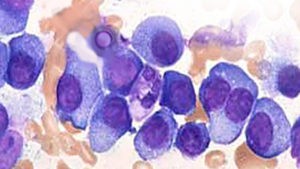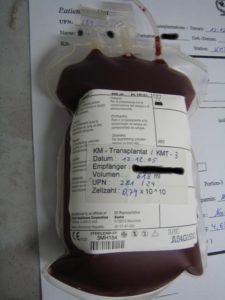
Recently Diagnosed or Relapsed? Stop Looking For a Miracle Cure, and Use Evidence-Based Therapies To Enhance Your Treatment and Prolong Your Remission
Multiple Myeloma an incurable disease, but I have spent the last 25 years in remission using a blend of conventional oncology and evidence-based nutrition, supplementation, and lifestyle therapies from peer-reviewed studies that your oncologist probably hasn't told you about.
Click the orange button to the right to learn more about what you can start doing today.
- You are here:
- Home »
- Blog »
- Multiple Myeloma »
- Autologous Stem Cell Transplant (ASCT) Still MMers WORST CHOICE-
Autologous Stem Cell Transplant (ASCT) Still MMers WORST CHOICE-
ASCT is aggressive, high-dose chemotherapy akin to using a sledge-hammer when a scalpel is needed. Novel chemotherapy regimens are the scalpel.
When I say that an early stem cell transplant (ASCT) is the newly diagnosed multiple myeloma patients’ worst choice, I mean that stem cell transplants are high-dose, aggressive chemotherapy that can:
- result in increased short, long-term and late stage side effects
- and that when compared to novel chemotherapy, the average patient’s length of life (overall survival) is the same and
- an ASCT is the patient’s most expensive therapy option.
So on average, an ASCT is more painful, more expensive and results in the same length of life. I consider these factors as measures that ASCT, on average, is the newly diagnosed MM patients worst choice.
However, please don’t take my word for it. Ask your oncologist. Ask your oncologist about the concepts mentioned in the UAMS study linked and excerpted below including:
- Novel MM Chemo vs. ASCT- which has a lower risk of DEATH?
- Novel MM Chemo vs. ASCT- which has a longer average overall survival?
- Novel MM Chemo vs. ASCT- which therapy plan has fewer side effects?
- Novel MM Chemotherapy regimens vs. ASCT- which therapy plan is cheaper?
Let me be clear. Chemotherapy regimens such as Revlimid, Velcade and Darzalex have improved the lives of newly diagnosed MM patients greatly over the past 20 years. I am saying that less is more in MM treatment.
ASCT is MORE. Lots more. Novel therapies such as Revlimid and Velcade are less. Clinical trials, according to the article links down the page can be misleading.
Knowledge is power in multiple myeloma. To learn more about the spectrum of MM therapies, both conventional and non-conventional, scroll down the page, post a question or comment and I will reply to you ASAP.
Good luck,
David Emerson
- MM Survivor
- MM Coach
- Director PeopleBeatingCancer
Recommended Reading-
- Multiple Myeloma Stem Cell Transplant- ASCT Exercise PreHabilitation- Finally!
- Multiple Myeloma Chemotherapy- Heart Damage Risk 300% Higher!
- Stem Cell Transplants Increase Risk of Skin Cancers
- Multiple Myeloma Therapy- Late effects of Stem Cell Transplant, often debilitating
Long-term outcomes after autologous stem cell transplantation for multiple myeloma
“Key Points-
- Long-term survival in MM patients treated with ASCT has improved with the introduction of novel therapeutics-
- Outcomes for older patients and those with low-risk disease improved, but those with high-risk disease still experience poor survival-
As multiple myeloma (MM) treatments evolve, frequent updates are required to monitor the long-term effect of changes in approach.
Traditionally, MM is considered an incurable disease, with most patients eventually relapsing. However, improvements in treatments has raised the possibility that MM might be functionally curable.
To examine improvements in long-term survival, we followed 4329 patients with newly diagnosed MM treated with autologous stem cell transplantation (ASCT) at the University of Arkansas for Medical Sciences from 1989 through 2018.
Overall survival (OS) and progression-free survival (PFS) were evaluated using Kaplan-Meier analysis, Cox proportional hazards models, relative survival analysis, and cure modeling among different time periods, risk groups, and demographic traits.
Steady improvements in OS were found, with patients treated in 2014 or later having superior OS and reduced excess risk for MM death compared with patients treated in 1997 or earlier.
Patients treated during intervening time periods often had intermediate survival, but trends in OS, PFS, and landmarked analyses were inconsistent.
Cure models support the potential for cure, ranging from 6.3% to 31.3%, depending on the year of treatment, with 10.0% to 18.6% of patients achieving their normal life expectancy across multiple periods.
There was some evidence of reductions in early mortality within 3 years of diagnosis, longer complete response (CR) duration, and reductions in relapse after achieving CR.
However, results differed depending on age, risk group, and cytogenetic characteristics…
Multiple Myeloma Clinical Trials for ASCT Misleading?
The median progression-free survival (PFS) and overall survival (OS) were significantly higher among (myeloma) patients who were trial-eligible
Multiple myeloma clinical trials are said to be “the gold standard.”Conventional oncology usually encourages newly diagnosed myeloma patients, regardless of stage at diagnosis, to begin treatment for their MM with induction therapy followed by an autologous stem cell transplant. This is standard-of-care for transplant eligible MMers.
Why is it standard-of-care? Not because MM patients who have a stem cell transplant live longer but because an ASCT confers a longer progression-free survival on average. PFS means that the patient, on average, has a longer first remission. The person lives longer before he or she progresses.
Multiple myeloma clinical trials have strengths and weaknesses. Clinical trials are particulaly confusing if you are an average person with little or no experience in the world of FDA approved therapies.
The articles linked and excerpted below are trying to explain one very important aspect of multiple myeloma clinical trials. And that is that inclusion and exclusion criterea for trials that involve MMers must be taken with a grain of salt. MM clinical trials involve younger, healthier MMers than real life. If you are over 65, if you have heart of kidney failure, for example, you will be exluded from the trial.
Let me be clear. I am not saying that MM patients don’t need chemotherapy. I am saying that high-dose therapy from an ASCT, according to research, imparts a great deal of toxicity- short, long-term and late stage side effects that may not come with lesser amounts of chemotherapy.
If you or a loved one have been diagnosed with Multiple Myeloma, let me say this loud and clear:
It is critical that you become an active participant in your care. Learn everything you can.
I am alive today largely because I took the time to find out everything I could about Multiple Myeloma and sought out the full spectrum of evidence-based MM therapies both conventional (FDA approved) and non-conventional.
Please watch the video below to learn more about the evidence-based, integrative therapies to combat treatment side effects and enhance your chemotherapy.
Recommended Reading:
- Gradual Response Better then Fast Response in Myeloma Therapy?
- Lose Weight, Fight Multiple Myeloma
- Multiple Myeloma and Vitamin D3 as Therapy
Survival of non-transplant patients with multiple myeloma in routine care differs from that in clinical trials-data from the prospective German Tumour Registry Lymphatic Neoplasms.
“Despite increasing treatment options, multiple myeloma (MM) remains incurable for most patients. Data on improvement of outcomes are derived from selected patient populations enrolled in clinical trials and might not be conferrable to all patients.
Therefore, we assessed the trial eligibility, sequential treatment, and survival of non-transplant patients with MM treated in German routine care. The prospective clinical cohort study TLN (Tumour Registry Lymphatic Neoplasms) recruited 285 non-transplant patients with symptomatic MM at start of first-line treatment in 84 centres from 2009 to 2011. Demographic and clinical data were collected until August 2016.
Trial-ineligibility was determined by presence of at least one of the common exclusion criteria: heart/renal failure, liver/renal diseases, polyneuropathy, HIV positivity. All other patients were considered potentially trial-eligible. Thirty percent of the patients in our study were classified as trial-ineligible.
Median first-line progression-free survival (PFS) and overall survival (OS) of trial-ineligible patients were inferior to that of potentially trial-eligible patients: PFS 16.2 months vs. 27.3 months; OS 34.2 months vs. 58.6 months.
A high percentage of non-transplant patients with MM in German routine care would be ineligible for participation in clinical trials. Despite similar treatment algorithms, their first-line PFS and OS were shorter than those of potentially trial-eligible patients; the survival data of the latter were similar to results from clinical trials. Physicians should be aware of the fact that results from clinical trials may not mirror “real world” patient outcomes when discussing outcome expectations with patients.”
Real-World Results Differ From Clinical Study Outcomes in Multiple Myeloma
“Survival outcomes in real-world practice may not mirror outcomes in clinical trials for non-transplant patients with multiple myeloma, according to research published in the Annals of Hematology (online August 1, 2018; doi:10.1007/s00277-018-3449-8).
While treatment options have increased significantly in recent years, multiple myeloma remains incurable for most patients. Improved outcomes data are derived from patient populations enrolled in clinical trials. However, these data may not be conferrable to all patients.
A group of German researchers led by Norbert Marschner, MD, outpatient center for interdisciplinary oncology and hematology (Freiburg, Germany), conducted a study to assess trial eligibility, sequential treatment, and survival of non-transplant patients with multiple myeloma treated in routine care. The prospective clinical cohort study (German Tumor Registry Lymphatic Neoplasms) enrolled 3795 patients with hematological malignancies after first- or second-line therapy. A total of 285 non-transplant patients received systemic treatment for multiple myeloma.
Among the ineligibility criteria were heart/renal failure, liver/renal diseases, polyneuropathy, and HIV-positive status. Thirty percent of the patients in the study were considered trial-ineligible.
Researchers reported that regardless of the intervention, the median progression-free survival (PFS) and overall survival (OS) were significantly higher among patients who were trial-eligible. The PFS was 16.2 months and 27.3 months for ineligible and eligible patients, respectively.
Similar trends were observed in OS data. Among ineligible and eligible patients, the median OS was 34.2 months and 58.6 months, and the 3-year OS rate was 44.4% and 69.4%, respectively.
“Despite similar treatment algorithms, trial-ineligible first-line PFS and OS were shorter than those of potentially trial-eligible patients; the survival data of the latter were similar to results from clinical trials,” authors of the study concluded. “Physicians should be aware of the fact that results from clinical trials may not mirror real-world patient outcomes when discussing outcome expectations with patients.”—Zachary Bessette



